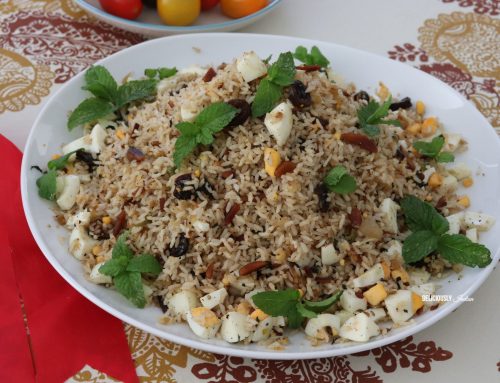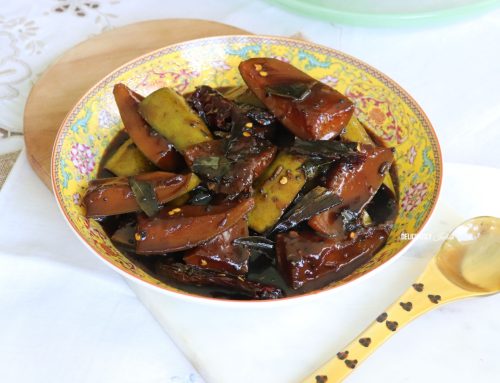Roast Chicken with Stuffing
The juiciest Indian inspired Roast Chicken with Stuffing for your Christmas lunch or dinner. The chicken is slathered in a spicy butter rub, then roasted perfectly until the skin is golden on the outside and juicy and tender on the inside. Yumm so juicy!!

It’s beginning to taste a lot like Christmas, with Christmas just three sleeps away. I am getting so excited about the big day and really looking forward to serving up a delicious roast as the centrepiece of my dinner table this Christmas. After many requests from some readers, and a lot of contemplating, followed by many trials, I have curated a perfect Indian inspired Roast Chicken with Stuffing recipe for you. Filled with this season’s goodness, this is a roast chicken that is golden on the outside and juicy on the inside, with slight zest from spices (Sri Lankan roasted curry powder) and pepper to remind you it’s there without overwhelming.
Roasts were a real delicacy when growing up and growing in Udupi, a roast was almost certainly a dream. The first time I tasted a roast was when my parents were invited to a wedding at the Valley View Hotel in Manipal (FYI the hotel still exists by the way), when I was very young. All my senses catapulted at the thought of tasting a delicious roast. I think I was a born foodie, but sadly, I do not remember whose wedding it was!!
If I can correctly recall, it was a roast stuffed pigling aka laithav in Konkani (my mother tongue). The pigling was golden and looked mouthwatering on the table. If you asked me how it tasted, I would probably say, unfortunately, time has lapsed, and the taste of that pigling is a total blur in my memory.
MY ULTIMATE ROAST CHICKEN WITH STUFFING
My version of roast chicken has a self-crafted buttery rub, made with a fusion of fragrant Sri Lankan roasted curry powder (so graciously gifted to me by my soon to be daughter-in-law, thank you S!), coarse milled pepper and sea salt flakes rubbed on the skin. It is stuffed with a delicious Indian inspired Rice, Almond and Sultana stuffing, and roasted until deep golden on the outside, and juicy on the inside.
This Roast Chicken with Stuffing will make a stunning centrepiece of your Christmas lunch or dinner table or at any time of the year.
This delicious stuffed roast chicken involves three steps:
- The first – prepare the Rice, Almond and Sultana stuffing (click the link in the recipe to watch a quick video of how to prepare the stuffing and if in doubt, check out my Step-by-Step tutorial to help guide you through every stage of making the stuffing).
- The second – stuff the breast cavity and truss the chicken (click the link on the recipe to watch a video on how to stuff the chicken and then truss it). In this step, I have intentionally created a slight degree of challenge to create a sense of fun and excitement. Please note, trussing is optional, but it will help your roasted chicken cook more evenly.
- The third – Roast the chicken.
The first step is really easy and follows a really lovely path, almost similar to making pulao but with this season’s goodness.
The second step might seem a little daunting at first, and you may think hmmm! I don ‘t want to truss the chicken. I can’t agree with you more, as I too was extremely reluctant as I thought trussing the chicken was a curvy windy road, literally! Then, I thought, a bit of fun and excitement wrapped in a tiny degree of challenge, is exactly what we should aim to keep us happy. Agree? So, don’t be put off, rise up to the challenge and give it a go. If you don’t get it right for the first time, don’t fret about it. Just cut off the twine, and try it again and again, until you get it right. You will be a pro after you truss a couple of times and also have fun doing it. If all fails, you can partly truss the chicken – just tie the legs together nice and snug, with the breast side up and tuck wings under the chicken. Done! Important: you must stuff the chicken before you truss, as trussing will cover the breast cavity when the legs are tied together.
The third step is the easy part – roast the bird. Rub the buttery mixture liberally all around the skin, ensuring you cover the nook and crannies of the wings and between the breast and thigh joints. Many of you would have roasted a chicken before and this roasting is no different.
Hope you enjoy making my version of Roast Chicken with Stuffing that is golden on the outside and juicy on the inside.

frequently asked questions
What size bird I should select?
The size of bird is tailored to the number of people at home. A 1.5 kg bird is enough to feed a family of 4 with some leftovers to make some sandwiches. If you are roasting a bird for a special occasion or in this case for Christmas, choose a large bird. I used an oversized bird weighing 2.6kg, as this will ensure lots of white meat to go around on the table.
Should I rinse the chicken or not before roasting?
No, the chicken does not need to be rinsed and rinsing does not wash away pathogenic bacteria. In fact, rinsing increases the chances of spreading bacteria around your sink and bench tops. Cooking chicken to an internal temperature of 74°C (165°F) will kill any bacteria present. Check out this article for more information on why chicken should not be rinsed.
Should I marinate the chicken?
Marinating is optional and can be tailored to your desired results. If you have time up your sleeve, you may marinate the chicken for 45 minutes at room temperature, so it can infuse chicken with savoury flavours.
Should I truss the chicken?
Trussing is optional, but it will help your roasted chicken cook more evenly. Read my blog below on the many benefits of trussing the chicken.
Is it safe to stuff the bird?
Stuffing adds flavour and elegance to plain chicken. However, food safety concerns require that the stuffing inside the chicken reach a temperature of 75°C/165°F, which is the same safe temperature for the body of the chicken. If you are not a fan of stuffed chicken, you could always serve the stuffing or dressing as a separate side dish on the table. Important: Remove any remaining leftover stuffing from inside the cavity within two hours of removing the stuffed chicken from the oven.
Should I cover the chicken with foil when roasting?
Yes, by all means, particularly if the recipe calls for it. I like to tent the chicken with foil, as from experience, the chicken tends to dry out quickly when it comes in contact with direct heat. Covering creates a barrier that prevents the surface from drying out, resulting in succulent meat. By covering the chicken, the flavours from the rub (seasoning) have a better chance of infusing into the meat, resulting in a more flavourful roast.
How long should a I roast a 2.6-2.8kg bird?
A large chicken weighing 2.6kg – 2.8kg takes approximately 25-30 minutes for every 500g in an oven preheated to 200°C. In this case, I covered the chicken with foil and roasted for 2½ hours and rested the chicken uncovered for 25-30 minutes. The total time for roasting and resting was approximately 3 hours. The result was a golden exterior and a juicy interior. This instruction should be used as a guide only, as ovens vary remarkably. Please use your discretion and tailor the timing to the instructions of your oven.
What is the safe temperature for roasting and stuffing?
The safe temperature for chicken and the stuffing in the cavity is 75°C/165°F. To test if chicken is cooked, when the time is up, insert the food thermometer into thickest part of the chicken (inner thigh area near the breast) and check if the temperature has reached 75°C/165°F. If not, roast for a further few minutes (say 10-15 minutes) and then check again. Another test is the juices should always run clear when cooked.
MY ULTIMATE ROAST CHICKEN WITH STUFFING
To make my juicy and tender roast chicken, you will first need to make a buttery rub. My rub is very simple and interesting, as I just wanted to get creative with what is stocked in my pantry. In my opinion, this garlic and spice butter rub takes the chicken from zero to hero!!
Mine is a 4 ingredient, self-crafted butter rub, and is made with softened butter (melt butter in cold conditions), sea salt flakes, coarse milled pepper and the secret ingredient is Sri Lankan roasted curry powder. The Sri Lankan roasted curry powder is great in chicken curries and I figured it should work well for a chicken roast too! And let me tell you, it worked perfectly!!
As many of you may not stock Sri Lankan roasted curry powder in your pantry, you can just skip the Sri Lankan curry powder and use either smoked paprika or bafat powder (the spice mix that many Mangaloreans stock) or even Kashmiri chilli powder. The secret is not to make the buttery rub very intense, as you do not want the rub to overpower the flavour of the chicken. Tailor the seasoning to your taste by increasing or decreasing pepper, curry powder | bafat powder | Kashmiri chilli powder and salt.
Smear a liberal coating of this butter rub in the cavity and on the surface of the chicken pre-roasting, making sure you apply under the wings and all around the legs. This rub will pick up a glorious red hue to your chicken when roasted!
Allow me to walk you through what you need to make this Roast chicken with stuffing:

- The chicken – I bought a large Steggles family roast chicken weighing 2.6 kg from my local supermarket. This chicken is fully cleaned, which means, it comes without neck and giblets. Trim any visible fat from the neck and the breast cavities before you roast. This recipe works for chicken weighing between 2.5kg to 2.8 kg and works perfectly for marinating and roasting. Once roasted, it serves 4-6 adults along with stuffing, vegetables and gravy. I suggest you cook 30 minutes for every 500g as this is a large bird and takes a little longer to cook. If your chicken is larger or smaller, you will need to adjust the timing accordingly.
- Butter softened – The secret to a golden chicken is softened or melted butter. Butter locks in moisture and gives the seasonings something to adhere to. Use salted (I used salted butter) or unsalted butter. If you use unsalted butter, taste the rub and adjust the salt to your preference. In wintery weather, melt the butter before adding the other ingredients.
- Sea salt flakes – Seasons the chicken delicately and gives a balanced saltiness. It adds a subtle salty flavour, which is perfect for this recipe. Feel free to use salt of your choice or any that is stocked in your pantry. If you are using any other salt, start by adding 1 teaspoon at a time and adjust to your taste as you go.
- Pepper – I have used coarsely ground pepper. I like the effect of those pepper speckles and a slight pepper kick in my roast. You may use pepper mill to grind black pepper corns. If all fails, use ground black pepper. Again, tailor pepper to your taste preferences.
- Sri Lankan roasted curry powder – This is my favourite Sri Lankan roasted curry powder and adds a wonderful flavour without overpowering. Substitute: 1 tbsp. of smoked paprika or 1 tbsp. of bafat powder (a staple in a Mangalore or Goan pantry) or 1 tbsp. of Kashmiri chilli powder. Increase or decrease the spice powder to your preference.
- Chicken stock – Added to cover the base of the roasting pan and please do not pour over the chicken. While the stock is steaming, it will infuse flavour into the chicken as it is roasting. Substitute: 1 cup of water.
should I truss the chicken or not
When roasting the whole bird, it is a good idea to truss it. Trussing the chicken is a culinary technique of tying the chicken snugly with a butcher’s twine or kitchen twine or cooking twine before cooking, so the wings and legs are close to the body.
Trussing the chicken is optional, but it will help your roasted chicken cook more evenly. Read below the benefits of trussing or tying the chicken securely:-
- Trussing holds the chicken in a uniform shape during cooking and serving it up.
- Trussing poultry makes the chicken compact which means, the wings and the legs are tied close to the body.
- A correctly trussed chicken roasts evenly throughout thus sealing in juices and flavour. As the juices are sealed in, the meat is tender.
- If you are planning to stuff the chicken, trussing the chicken will hold the stuffing in place, without falling apart.
- Trussing prevents some parts from burning or overcooking, as the wings and legs are close to the body, allowing the heat to penetrate to different parts of the chicken evenly.
- A trussed chicken elevates the taste and aesthetics on the dining table.
- A well trussed chicken is easier to carve.
watch how to make it
Learn how to make this!
Roasting a whole chicken may seem intimidating but it doesn’t need to be. Here’s my easy Step-by-Step tutorial for a perfect Indian inspired roast chicken that is golden on the outside and tender on the inside.
The full instructions to make this Indian inspired Roast chicken are in the recipe card below, but here are some helpful tips to go along with the process photos.
Here’s what we are trying to achieve at each step in this video:

Preheat oven to 200°C and prep the chicken
Remove any excess fat from the neck and the breast cavities and thoroughly pat the chicken dry with paper towels. For a golden chicken, there should be no moisture inside the cavities and on the surface of the chicken.



Prepare the buttery mixture | rub
In a small bowl, combine butter, salt flakes, pepper and Sri Lankan roasted curry powder (if using). Smear 1 teaspoon of the butter mixture | rub into the breast cavity.



position the chicken and stuff the cavity
Place the chicken on a large cutting board with the breast-side up and the drumsticks (legs) facing toward you. Stuff the cavity loosely with the Rice, Almond and Sultana Stuffing prepared in Step 1 of the recipe. Reserve the rest for serving as a side dish on the table.



truss the chicken securely with cooking twine
Click on Trussing a Stuffed Chicken to learn how to truss the chicken. Just to give you an idea below is an image of a trussed chicken without stuffing (left image) and a trussed with stuffing (right image). The one on the right is ready to be roasted.



roast the chicken
Add 1 cup of water or stock to a large roasting pan. Set chicken on a greased roasting rack with breast-side up and place the rack in the roasting pan. Tent with foil and place the chicken in the oven. Baste chicken after 20 minutes with pan juices. After the chicken has roasted for 2 hours, remove the foil. When the chicken has roasted for 2 hours and 15 minutes, check the temperature with an instant-read thermometer inserted into the thickest part of the thigh without touching the bone. The thermometer should read at least 75°C/165°F. If not yet at temperature, roast for another 15 minutes and check again. I roasted my chicken for 2 hours and 30 minutes.



remove chicken from oven and rest
When the chicken and the stuffing (check the temperature of the stuffing too) has reached an internal temperature of 75°C/165°F (see image below), remove the roasting pan from the oven. Transfer the roasting rack carefully to large tray lined with foil or transfer the chicken to a serving platter. Rest uncovered for 20-25 minutes. This allows the juices to set and makes slicing easier. To remove the stress out of baking, I have invested in a meater (a probe) which gives me a perfectly roasted chicken every time. My best investment ever!!



Finish the remaining dressing
While the chicken is resting, finish the dressing. Heat 3 tsp. of ghee or oil in a large non-stick frying pan on low to medium heat. Add the remaining stuffing and toss well until heated through.



cut off the twine and serve
Once the chicken has rested, cut off the twine. Now your chicken is ready to be served. Remove the stuffing from inside the cavity on to the platter. Serve the whole chicken with the dressing around the chicken or as a side dish (as shown in the image below) accompanied by roasted vegetables and carve as you go. Alternatively, you may serve the chicken carved with a gravy of your choice.


serving suggestions
- I like this succulent chicken served on its own with some roast vegetables and stuffing.
- If you are fan of the gravy, then serve with your favourite chicken gravy.
- If you are a fan of the stuffing from the cavity, then go ahead and serve yourself some stuffing from the cavity and also some stuffing from the side. Enjoy!!


HAVE YOU MADE THIS RECIPE?
Let me know how it went! Tag me on Instagram @lavina_mendonsa or leave a comment below!

Roast Chicken with Stuffing
Ingredients
- 1 large chicken 2.6kg - 2.8kg
For the butter mixture
- 3 tbsp. butter softened or, melted approx. 70g
- 4 teaspoon sea salt flakes 16g
- 2 tbsp. coarsely ground black pepper 12g
- 1 heaped tbsp. smoked paprika or bafat powder or Sri Lankan roasted curry powder 10g (optional) (I used Sri Lankan roasted curry powder)
- 1 cup/250mL water or chicken stock if you are using pan juices to make gravy
Instructions
- Preheat oven to 200°C or 390°F.
- If the chicken is in the refrigerator, bring it out and leave to rest on the kitchen bench for an hour. This will allow it to come to room temperature, so it can cook evenly. Remove any excess fat from the breast and neck cavities. Thoroughly pat the chicken dry inside and out with paper towels.
- To make the rub | butter mixture, combine butter, sea salt flakes, pepper, smoked paprika/bafat powder/Sri Lankan curry powder (if using) (NOTE 1) in a small bowl.
- Smear 1 tsp. butter mixture into the breast cavity. Ensuring the stuffing is at room temperature, loosely fill breast cavity with stuffing (NOTE 2). Reserve rest of the stuffing in the refrigerator in an airtight container to serve as a side (dressing) on the table.
- Truss the stuffed chicken securely with cooking twine. This step in optional, but it will help your roasted chicken cook more evenly (NOTE 3).
- Pierce the chicken in a few places with a fork and smear the rest of the rub | butter mixture liberally on all sides.
- Add 1 cup water or chicken stock to a large roasting pan (NOTE 4). Place chicken with the breast-side up on a greased roasting rack (I used a V shaped rack, you may use any rack you have). Tent with foil. Place the rack in the roasting pan. Roast for 20 minutes. Baste chicken with pan drippings. Then roast covered for 25-30 minutes per 500g of chicken (a 2.6 kg bird will take approx. 2½ hours). This instruction should be used as a guide only, as ovens vary remarkably. Roast in accordance with the guidelines of your oven.
- When the time is up, test if chicken is cooked. To test, insert the food thermometer into the thickest part of the chicken (NOTE 5). The safe temperature for chicken and the stuffing is 75°C/165°F. Another test is, when pierced the juices of the chicken should always run clear when cooked.
- Remove from the oven. Gently transfer the roasting rack to a serving platter or cutting board or another large tray lined with foil. Rest uncovered for 20-25 minutes. This allows the juices to settle and makes slicing easier.
- While the chicken is resting, finish the remaining dressing (stuffing). Add 3 tsp. ghee or oil to a non-stick frying pan and heat on low to medium. Add the remaining stuffing and toss well till heated through. Remove from heat and set aside until the chicken has rested.
- After the chicken has rested, gently remove from the rack and place on to the platter. Spoon some pan juices over the chicken. Arrange the warm stuffing around the chicken along with some roasted vegetables. Alternatively, serve the stuffing as a side dish separately. Carve and serve on its own or with your favourite chicken gravy.
Notes
- Increase or decrease seasonings (pepper, smoked paprika/bafat powder/Sri Lankan roasted curry powder) as per your preference. If you do not stock smoked paprika or bafat powder or Sri Lankan curry powder, skip these, and add only pepper).
- Stuffing loosely allows for some expansion during roasting. Do not pack stuffing into the cavity. You must stuff the chicken before trussing, as trussing the legs together will cover the cavity.
- If you find my way of trussing difficult, then truss it the easy way. The easiest way is to tie the legs (drumsticks) nice and snug together with a cooking twine, so they are close to the body. Tuck the wings under the body without any twine.
- You may use water or stock at the bottom of the roasting pan. Adding liquid creates moisture and helps keep the chicken meat juicy and tender. It will also prevent drippings from scorching. I have used chicken stock.
- The thickest part (inner thigh area) is between the breast and the drumstick. Place the thermometer in the thickest part to read the safe temperature. Ensure chicken is properly cooked before the resting stage. The safe temperature for chicken is 75°C/165°F. The safe temperature for the stuffing is also 75°C/165°F.
- You must remove the stuffing from the cavity within two hours of the chicken coming out of the oven.




